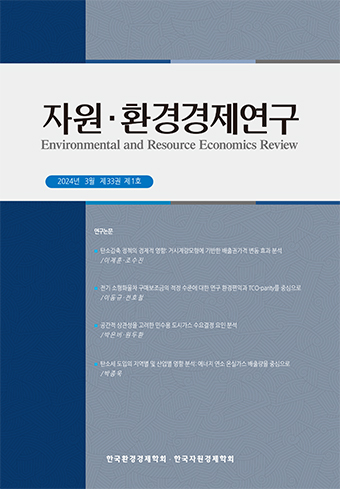Research Paper
Abstract
References
Information
We extend and modify the canonical epidemiology model of Eichenbaum, Rebelo and Trabandt (2020) to investigate the general equilibrium effects of COVID-19 spread in the Korean economy when vaccine, treatment and social distancing are available. Particularly, we develop a SIR-macro model which considers possibility of moral inattention of the overconfident agents through which people is more likely to be infected. Our model implies that people’s decision to cut back on consumption and work reduces the severity of the epidemic and thus exacerbate the size of the economic recession caused by the epidemic. Another finding is that the average 13 weeks to develop the vaccine and treatment will lead to 2% drop of consumption.
본 연구는 코로나19 확산에 대응한 최적 방역정책이 국내 거시경제에 미치는 동태적 효과를 분석하였다. 백신, 치료제, 사회적 거리두기의 다양한 조치가 취해지는 상황에서 감염병 예방노력의 도덕적 부주의를 결합한 거시-역학 모형을 제시하였다. Eichenbaum, Rebelo and Trabandt(2020)의 거시-역학 모형에 도덕적 부주의 상황을 추가하였으며, 확산모형을 이용하여 국내의 코로나19 감염율을 추정하였다. 사회적 후생을 극대화하는 램지 문제의 동태적 분석결과는 사람들의 일상 중 생활속 거리두기 준수가 정부의 방역정책과 치료제, 백신 도입이 효과를 발휘하는 데 매우 중요한 역할을 한다는 점을 시사한다. 도덕적 부주의가 있는 경우의 최적 방역정책은 2배 더 강화되어야 하며, 총소비는 7% 하락하고, 회복하는 데 저점부터 12주가 소요된다. 백신과 치료제 개발에 성공하는 데 평균 13주 소요되는 경우에 총소비는 2% 하락하는 것으로 도출되었다.
- Alvarez, F., D. Argente, and F. Lippi,
A Simple Planning Problem for COVID-19 Lockdown,î manuscript , University of Chicago, 2020.10.3386/w26981 - Atkeson, A.,
What will be the economic impact of COVID-19 in the US? Rough estimates of disease scenarios , NBER Working Paper No. 26867, National Bureau of Economic Research, 2020. 10.3386/w26867 - Eichenbaum, M. S., S. Rebelo, and M. Trabandt,
The Macroeconomics of Epidemics. NBER Working Paper No. 26882 , National Bureau of Economic Research, 2020.10.3386/w26882 - Jones, C. J., T. Philippon, and V. Venkateswaran,
Optimal Mitigation Policies in a Pandemic: Social Distancing and Working from Home. NBER Working Papers 26984 , National Bureau of Economic Research, 2020.10.3386/w26984 - Kermack, W. O., and A. G. McKendrick, “A Contribution to the Mathematical Theory of Epidemics,”
Proceedings of the Royal Society of London , series A 115, No 772, 1927, pp. 700~721.10.1098/rspa.1927.0118 - Kozlowski, J., L. Veldkamp, and V. Venkateswaran,
Scarring Body and Mind: The Long-Term Belief-Scarring Effects of COVID-19 , the 2020 Jackson Hole Economic Policy Symposium Proceedings Working paper, 2020.10.3386/w27439 - Kremer, M., “Integrating Behavioral Choice into Epidemiological Models of AIDS,”
The Quarterly Journal of Economics , Vol. 111, No. 2, 1996, pp. 549~573.10.2307/2946687 - Park, H. and S. H. Kim, “A Study on Herd Immunity of COVID-19 in South Korea: Using a Stochastic Economic-Epidemiological Model,”
Environmental and Resource Economics , Vol. 76, 2020, pp. 665~670.10.1007/s10640-020-00439-8 - Park, K. and B. Choi, “Efficiency Wage and Cyclical Asymmetry,”
Journal of Economic Theory and Econometrics , Vol. 26, No. 2, 2015, pp. 1~35. - Shen, M., J. Zu, C. K. Fairley, J. A. Pagan, L. An, Z. Du, Y. Guo, L. Rong, Y. Xiao, G. Zhuang, Y. Li, and L. Zhang,
Projected COVID-19 Epidemic in the United States in the Context of the Effectiveness of a Potential Vaccine and Implications for Social Distancing and Face Mask Use , Vaccine, https://doi.org/10.1016/j.vaccine.2021.02.056, 2021.10.1016/j.vaccine.2021.02.056 - Walsh, C. E., “Labor Markets Search, Sticky Prices, and Interest Rate Policies,”
Review of Ecoomic Dynamics , Vol. 8, No. 4, 2005, pp. 829~849.10.1016/j.red.2005.03.004
- Publisher :Environmental and Resource Economics Review
- Publisher(Ko) :자원 · 환경경제연구
- Journal Title :자원·환경경제연구
- Journal Title(Ko) :Environmental and Resource Economics Review
- Volume : 30
- No :1
- Pages :27-48
- DOI :https://doi.org/10.15266/KEREA.2021.30.1.027



 자원·환경경제연구
자원·환경경제연구






